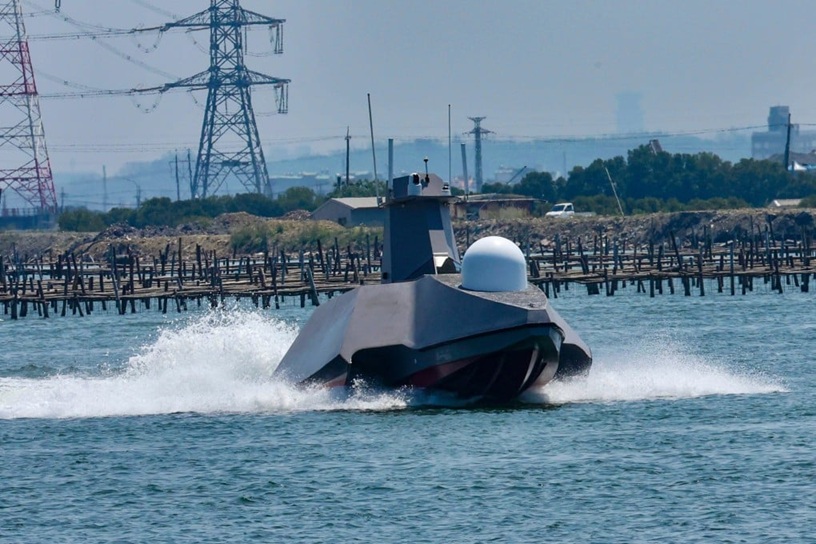As tensions in the Taiwan Strait continue to escalate, Taiwan is stepping up its defense game with the development of kamikaze sea drones—unmanned maritime vessels designed to strike enemy ships with explosive force. This strategic shift marks a significant advancement in Taiwan’s asymmetric defense capabilities, designed specifically to deter and counter China’s growing military pressure.
A Rising Threat from Across the Strait
China has long viewed Taiwan as a breakaway province, vowing eventual reunification, by force if necessary. Over the past few years, Beijing has significantly increased its military activity around the island. Chinese fighter jets routinely cross into Taiwan’s air defense identification zone, and Chinese warships frequently patrol nearby waters. These moves have raised global concerns about a potential conflict in the Indo-Pacific, one that could have serious geopolitical and economic consequences.
In response, Taiwan has focused on developing a new generation of defensive technologies that can provide high impact at low cost. Central to this strategy is the idea of asymmetric warfare—the use of unconventional tools and tactics to offset the advantages of a larger adversary. The kamikaze sea drones are a powerful example of this approach.
What Are Kamikaze Sea Drones?
Kamikaze sea drones, also known as unmanned surface vehicles (USVs) or explosive drone boats, are remote-controlled vessels packed with explosives and designed to ram into enemy ships. Upon impact, the drone detonates, damaging or destroying its target. Unlike traditional naval mines or torpedoes, these drones can be maneuvered in real time, allowing for more precise targeting and flexible deployment.
Taiwan’s sea drones are reportedly modeled after successful examples used in other global conflicts, such as those employed by Ukraine against Russian warships in the Black Sea. The idea is simple but highly effective: use small, fast, and inexpensive drones to disrupt or destroy much larger and more expensive warships.
Leveraging Asymmetric Advantages
Taiwan’s strategic challenge is clear: it faces one of the largest and most modern militaries in the world. The People’s Liberation Army Navy (PLAN) boasts aircraft carriers, destroyers, amphibious assault ships, and a growing fleet of submarines. Taiwan, in contrast, maintains a relatively small navy.
Given this imbalance, Taiwan is increasingly relying on smart technology rather than raw numbers. Kamikaze sea drones are cost-effective, hard to detect, and capable of inflicting significant damage. According to defense analysts, a single drone costing less than $100,000 could potentially cripple or sink a warship worth hundreds of millions of dollars.
Additionally, these drones can operate in “swarms”—multiple units launched simultaneously to overwhelm enemy defenses. This tactic complicates detection and interception efforts, increasing the chances of mission success.
Development and Deployment
Taiwan’s kamikaze drone program is reportedly spearheaded by its National Chung-Shan Institute of Science and Technology (NCSIST), the government’s top defense research agency. While official specifications remain classified, sources suggest these drones are capable of traveling long distances, using GPS or AI-assisted navigation, and carrying substantial explosive payloads.
The sea drones are believed to be deployable from various platforms, including naval ships, coastal launchers, and possibly even converted commercial vessels. This flexibility allows Taiwan to quickly mobilize its drone fleet in response to emerging threats.
In a recent test demonstration, several prototypes were seen operating in formation, executing coordinated maneuvers designed to simulate an attack scenario. The success of these tests has reportedly accelerated the production phase, with several hundred units expected to be deployed along Taiwan’s coastline in the coming years.
A Message to Beijing—and the World
Beyond their tactical use, Taiwan’s sea drones send a clear strategic message: the island is prepared to defend itself with determination and innovation. While the military gap between Taiwan and China remains significant, the introduction of such advanced and unconventional weapons complicates any plans for a Chinese amphibious invasion.
Moreover, these developments serve as a reminder that modern warfare is evolving. Nations with limited resources can still pose serious challenges to more powerful adversaries by leveraging smart, adaptable technologies.
Taiwan’s allies, particularly the United States and Japan, have voiced support for the island’s right to self-defense. Although these kamikaze drones are homegrown, it is likely that Taiwan has benefited from technical insights and shared experiences from other democratic nations facing similar threats.
Challenges and Risks
While promising, the use of kamikaze drones also carries challenges. Effective use requires advanced command-and-control infrastructure, cybersecurity protection, and constant upgrades to keep up with adversary countermeasures. China, for example, may respond by enhancing its electronic warfare capabilities to jam or hijack these drones.
There are also concerns about escalation. The introduction of explosive unmanned vessels into the region’s already tense maritime environment could increase the risk of miscalculation or accidental conflict.
Nevertheless, Taiwan’s leaders appear undeterred, viewing these drones as essential tools in a broader deterrence strategy.
Conclusion
Taiwan’s development of kamikaze sea drones marks a bold and innovative step in countering the growing military threat from China. These unmanned vessels offer a potent mix of speed, stealth, and striking power, giving Taiwan a new layer of defense in an increasingly dangerous neighborhood.
As the balance of power in the Taiwan Strait continues to shift, the ability to think asymmetrically—using smaller, smarter, and more agile systems—may well be Taiwan’s greatest advantage. Whether or not these drones are ever used in combat, their mere presence could help keep the peace by raising the stakes for any potential aggressor.
